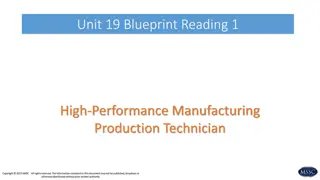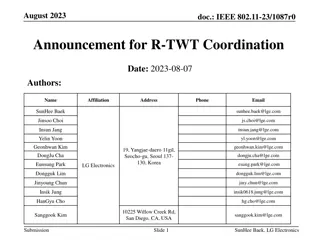Fingerstick Blueprint Public Comment Announcement
MDIC is a collaborative platform dedicated to advancing regulatory science for medical devices, focusing on improving study design for POC devices using fingerstick specimens. The announcement period is from March 4 to April 5, 2021. Explore the challenges and advantages of fingerstick samples in POC testing, with insights from prominent panelists and subject matter experts.
Download Presentation

Please find below an Image/Link to download the presentation.
The content on the website is provided AS IS for your information and personal use only. It may not be sold, licensed, or shared on other websites without obtaining consent from the author.If you encounter any issues during the download, it is possible that the publisher has removed the file from their server.
You are allowed to download the files provided on this website for personal or commercial use, subject to the condition that they are used lawfully. All files are the property of their respective owners.
The content on the website is provided AS IS for your information and personal use only. It may not be sold, licensed, or shared on other websites without obtaining consent from the author.
E N D
Presentation Transcript
Fingerstick Blueprint Public Comment Announcement Comment Period: March 4 April 5, 2021 March 4, 2021
Who We Are MDIC is a 501 (c)(3) and public-private partnership created with the sole objective of advancing regulatory science of medical devices for patient benefit. 63 participating member organizations Government FDA CMS NIH 300+ subject matter experts involved in working groups 70+ resources available to download in our digital resource library Industry Non-Profits Patients Providers Academics Device Diagnostics 20+ active working groups and committees Resources People Intellectual Capital 2 2 2 2
MDICx Panelists Timothy Stenzel, MD, PhD, Director of Office of In Vitro Diagnostics and Radiological Health | OHT7 | CDRH | FDA Shridhara Alva, PhD, Senior Director, Clinical Affairs | Abbott Diabetes Care (Working Group Chair) Corinne Fantz, PhD, Director, Medical and Scientific Affairs- POC | Roche Diagnostics Corporation Rex Astles, PhD, Acting Lead, Data Science Team | Center for Disease Control and Prevention 3 3
Timothy Stenzel, MD, PhD Director of Office of In Vitro Diagnostics and Radiological Health | OHT7 | CDRH | FDA
The Issue: Increasing need for scientifically sound and practical study design recommendations when evaluating analytical performance characteristics of POC devices, including CLIA waived and non-CLIA waived devices, utilizing capillary whole blood specimens (fingerstick specimens) 5 5
Fingerstick samples Advantages for POC testing small sample volume ease of sample collection fast sample collection and testing Challenges for assay validation small sample volume subject recruitment sample stability biological variations 6 6
Carolyn Hiller, MBA MDIC | Program Director, Clinical Dx
Working Group Assembled Subject Matter Experts from: FDA | CDRH | OIR CDC Industry Expert Advisors 8 8
MDIC Fingerstick Blueprint Working Group: Industry: *Shridhara Alva, PhD, Abbott Jacqueline Barrows, RN, ICON plc Corinne Fantz, PhD, Roche Maria Figueroa, Abbott Pam Frank, Abbott Ian Giles, MD, Sysmex Eileen Hiller, BD Gordon McFarlane, PhD, ICON Peter Shearstone, Thermo Fisher Scientific Government: MDIC: J. Rex Astles, PhD, CDC Carolyn Hiller, Program Director, Clinical Diagnostics Marina Kondratovich, PhD, FDA | CDRH | OIR Marianela Perez-Torres, PhD, FDA | CDRH | OIR Expert Advisors: *Working Group Chair Susan Alpert, PhD, MD Alberto Gutierrez, PhD 9 9
Survey of experience We heard from: IVD Industry Regulatory Agency: such as FDA, Health Canada, etc. Contract Clinical Research Organizations Regulatory consultants 10 10
Survey Illuminated Greatest Pain Points: Precision Method Comparison 11 11
The Blueprint includes: Definitions/Acronyms Regulatory Considerations for POCT Devices Study Designs for Candidate Device Clearance/Approval (both Non-Waived and CLIA Waived Tests) Considerations for the Use of Surrogate Samples Considerations for Data Analysis in Method Comparison and Precision Studies Additional Considerations for Precision Studies with Fingerstick Samples 12 12
Shridhara Alva, PhD Senior Director, Clinical Affairs | Abbott Diabetes Care | MDIC Fingerstick Blueprint Working Group Chair
Purpose of the Blueprint A study design blueprint for using data from capillary whole blood collected by fingerstick for analytical validation of IVD tests. - General guidance on considerations for study design. - Specific devices may require modifications in order to implement these studies. Reading and following this document neither guarantees FDA approval/clearance nor payment from insurance companies. 14 14
Study Design for a Non-Waived Test Fingerstick only Test environment POCT site Site 1 Studies to be performed at each site Method Comparison Candidate device tested with fingerstick by trained operators Vs Comparator method by laboratory professionals 2 Precision Evaluation - Reproducibility study using plasma/serum or liquid control AND - Reproducibility study with fingerstick samples - Design A (method comparison + precision study) OR - Design B (a separate precision study) 3 Internal site n/a Matrix Comparison study of fingerstick vs. plasma/serum or liquid control for analytical performance evaluation by laboratory professionals Evaluation of between-lot and between-instrument variability using plasma/serum or liquid control 16 16
Study Design for a Non-Waived Test Fingerstick and Venous Samples Test environment POCT site Site 1 Studies to be performed at each site Method Comparison Candidate device tested with fingerstick and venous sample (with one anticoagulant) by trained operators Vs Comparator method by laboratory professionals 2 Precision Evaluation - Reproducibility study using plasma/serum or liquid control AND - Reproducibility study with fingerstick samples and venous samples - Design A (method comparison + precision study) OR - Design B (a separate precision study) 3 Internal site n/a Matrix Comparison study of fingerstick and venous samples vs. plasma/serum or liquid control for analytical performance evaluation by laboratory professionals Matrix comparison study for different anticoagulants (anticoagulant 1 vs. anticoagulant 2 ) Evaluation of between-lot and between-instrument variability using plasma/serum or liquid control 17 17
Study Design for a Non-Waived Test Fingerstick and Venous Samples: Special Situations Test environment POCT site Site 1 Studies to be performed at each site Method Comparison Candidate device tested with venous sample (with one anticoagulant) by trained operators Vs Comparator method by laboratory professionals 2 Precision Evaluation - Reproducibility study using plasma/serum or liquid control AND - Reproducibility study with venous samples - Design A (method comparison + precision study) OR - Design B (a separate precision study) 3 Internal site n/a Matrix Comparison study of fingerstick and venous samples vs. plasma/serum or liquid control for analytical performance evaluation by laboratory professionals Evaluation of between-lot and between-instrument variability using plasma/serum or liquid control Consult regulatory agency for acceptability of this study design 18 18
Precision Studies Precision studies should be able to provide estimates of following components of variance: repeatability between-run between-day between-lot between-calibration between-instrument between-operator between-site 19 19
Precision Studies for non-Waived Test Different studies for different components of Variance Sample Repeatability Between-day Between- lot Study 3 Between- instrument Study 3 Between- operator Study 1 Between-site Surrogate sample Fingerstick sample Study 1 Study 1 Study 1 Study 2 Study 2 POCT Sites: Study 1: Test with surrogate samples, different components of variance such as repeatability, between-run (if applicable), between-day, between-operator, and between-site components can be evaluated. Study 2: Test FS samples, repeatability with FS and between-POCT operator components can be evaluated. Manufacturer s site Study 3: In addition, precision between lots and between instruments should be determined at the manufacturer s internal site in a separate precision study. 20 20
Design A: Method Comparison + Precision Study Fingerstick Samples Test environment POCT site Site 1 Studies to be performed at each site Method Comparison + Precision Study Candidate POCT device, Patient 1, Test 1, Operator 1 Candidate POCT device, Patient 1, Test 2, Operator 2 vs. Comparator method by laboratory professionals 2 Precision Evaluation Reproducibility study using plasma/serum or liquid control 3 21 21
Design B: Precision Study Fingerstick Samples Test environment POCT site Site 1 Studies to be performed at each site Each subinterval has five patients Each patient is tested by two operators Total of four fingerstick for each patient 2 Candidate POCT device, Patient 1, Test 1, Operator 1 Candidate POCT device, Patient 1, Test 2, Operator 1 Candidate POCT device, Patient 1, Test 3, Operator 2 Candidate POCT device, Patient 1, Test 4, Operator 2 3 Precision Evaluation Reproducibility study using plasma/serum or liquid control 22 22
Study Design for a Waived Test Fingerstick Samples Test environment POCT site Site 1 Studies to be performed at each site Operator Comparison Candidate device, Patient 1; Sample 1, untrained operator vs. Candidate device, Patient 1, Sample 2, trained operator 2 Comparison of Precision Precision comparison of untrained and trained operators Design A (operator comparison + precision study) or Design B (a separate precision study) 3 23 23
Study Design for a Waived Test Fingerstick + Venous Samples Test environment POCT site Site 1 Studies to be performed at each site Operator Comparison for Fingerstick Candidate device, untrained operator (2 operators per patient) Vs trained operator(2 operators per patient) for each patient 2 Operator Comparison for Venous samples (each anticoagulant) Candidate device, anticoagulant 1, untrained operator Vs anticoagulant 1, trained operator for each patient 3 Comparison of Precision with Fingerstick and Venous Samples Precision comparison of untrained and trained operators Design A (operator comparison + precision study) or Design B (a separate precision study) 24 24
Precision Study Design for a Waived Test Design A - Each patient is tested Design B - Each site test 5 patients per subinterval - 4 Fingerstick tests per patient - 5 Fingerstick tests per patient - 3 untrained operators and 2 trained operators per site - 3 untrained operators and 2 trained operators per site - Operators are randomized - Operators are randomized 25 25
CLIA Waiver Studies for a New Device Fingerstick only Test environment POCT site Site 1 Studies to be performed at each site Method Comparison Candidate device tested with fingerstick by untrained operators Vs Comparator method by laboratory professionals 2 Precision Evaluation by untrained operator - Reproducibility study using plasma/serum or liquid control AND - Reproducibility study with fingerstick samples - Design A (method comparison + precision study) OR - Design B (a separate precision study) 3 Internal site n/a Matrix Comparison study of fingerstick vs. plasma/serum or liquid control for analytical performance evaluation by laboratory professionals Evaluation of between-lot and between-instrument variability using plasma/serum or liquid control 26 26
Design Considerations for Precision Studies Test method Test levels should cover the measurement range + medical decision levels Number of test devices, reagent lots, test sites, test days Presentation of different components of variability 27 27
Corinne Fantz, PhD Director, Medical and Scientific Affairs | Roche Diagnostics Corporation
Method Comparison Non-Waived Test Design Considerations Combined data set should have samples spanning the measurement range, approximately uniformly Each site should try to include samples across the span of the measurement range A total of 120 patients should be enrolled for the method comparison study for a nonwaived test Surrogate samples are not recommended Minimum 3 test sites and 2 operators per site 29 29
Method Comparison Waived test Sequential Approach Combined data set should have samples spanning the measurement range, approximately uniformly Each site should try to include samples across the span of the measurement range A total of 240 patients should be enrolled for the method comparison study for a waived test Surrogate samples are not recommended Minimum 3 test sites and 1-3 untrained operators per site (total 9 untrained operators) 30 30
Method Comparison Waived test Dual Approach Combined data set should have samples spanning the measurement range, approximately uniformly A total of 360 patients should be enrolled for the method comparison study for a waived test Provisions are provided for situations where only trained operators are allowed to perform test for some subintervals Takes into account systematic difference between trained operator and untrained operator established in a different subinterval 31 31
Method Comparison Use of Surrogate Samples Unmodified patient samples provide best assessment of performance When surrogate samples are used, evidence that surrogate samples are true representation of the unmodified fingerstick samples should be provided. Different design approaches are provided Consult regulatory agency for acceptability of this study design 32 32
Comparator Method Legally marketed traceable calibration method or well validated method In the absence of a reliable laboratory analyzer, another cleared POCT device may be used Consider sample type variations not all comparator methods are validated to use fingerstick samples Understand the concentration difference between sample types and adequately address Consult regulatory agency for acceptability of this study design 33 33
Method Comparison Data Analysis and Presentation Minimize oversampling In study design After study completion Not performing comparator test on excessive samples Weighted regression Random deletion of excessive samples for overfilled bins 34 34
Matrix Comparison Design Considerations Matrix comparisons are done Between fingerstick and surrogate samples Venous samples with different anticoagulants 40 pairs of results in each sample type covering the measurement range For repeatability testing, two replicates are required This study can be performed at one site or at the manufacturer s internal site 35 35
Download the Draft Blueprint here: https://mdic.org/fingerstickdraft Additional Questions? Diagnostics@mdic.org























